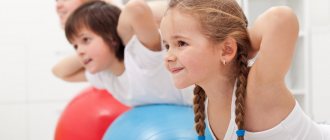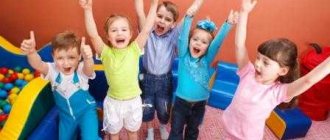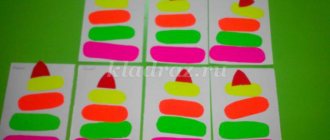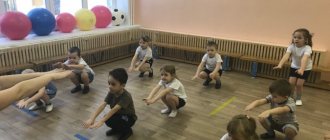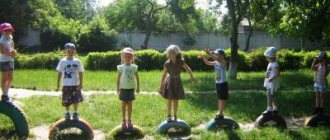Article on the topic “Why is physical education needed in kindergarten”
Physical education in kindergarten.
What is the most important thing in raising children? The child must grow up healthy. A healthy child is easier
to educate, he quickly develops all the necessary knowledge and skills. Health -
the most important prerequisite for the correct formation of character, development of initiative, strong
will, talents, natural abilities.
The purpose of physical education is a positive impact on vital functions
human body. Preschool age is considered the most important for physical,
mental and mental development of the child. During this period, the foundations of his health are laid.
Therefore, the main task of physical education and health work is to
promote health and improve the physical development of preschoolers.
The health of children in the Russian Federation is classified as a priority area of social
education policy. As part of the implementation of the Education and Health program
Of particular importance is the introduction of the most effective forms of children’s health improvement in
preschool education system.
Physical education and health work in kindergartens is now receiving increased attention,
because a significant proportion of children have health problems, and many children
can be classified as frequently ill. As you know, regular physical exercise
strengthen the body and help improve immunity. Moreover, children, unlike
adults are very mobile and active, so they simply need to periodically “let out
steam", and for this purpose, as well as for improving coordination of movements, physical education
fits like nothing else.
Physical education is an integral part of the intellectual, moral and aesthetic
raising a child. Playing sports also helps develop important personality traits:
persistence in achieving goals, perseverance; positive results from these sessions
beneficial for the mental state of a teenager. Caring for a child's motor development
just as important for its harmonious development as a rational regime, regular and
nutritious food, adequate sleep, frequent exposure to fresh air, clean bed and
necessary clothing.
Organizing physical education classes in our kindergarten.
Forms of physical education and health work:
physical education + exercises using exercise equipment and game stretching elements;
morning exercises; physical education minutes; gymnastics of waking up after a nap;
independent motor activity of children in a group; organized and independent
motor activity of children during a walk; physical education, entertainment, holidays,
Health weeks, Olympic week; holidays with parents.
Physical education classes are held 3 times a week. Their duration depends on age
children and amounts to:
· in the younger group – 15 minutes;
· in the middle group – 20 minutes; · in the senior group – 25 minutes; (classes in the senior group are conducted as in physical education
indoors and outdoors on the sports ground). One of the 3 classes per week is held in the form
classes using children's simulators and the TISA training system, the purpose of these
activities, first of all, is the prevention of diseases of the musculoskeletal system,
posture disorders and flat feet.
Physical education can be carried out either with or without musical accompaniment.
In physical education classes, children are taught in a playful way to long jump, high jump, jump on
“step”, jump on one and two legs, run, squat, walk like a train, crawl,
climb the wall bars, catch and throw balls at the target. In addition, different types are being studied
walking and running (the child learns to walk, “like a club-footed bear”, “like a fox” - lean on
different parts of the foot, jump “like a bunny bunny”, raise your knees high, perform
jumps). In older groups, relay races with overcoming obstacles are held for children
(climb under the crossbar, jump over the barrier, run like a snake).
Physical education uniform for kindergarten.
The child must have a special uniform for physical education - this, in
First of all, it is a matter of hygiene, as well as discipline. Having one sports uniform
directions develops team spirit in children during relay races and sports
holidays. Black shorts and a white T-shirt made of non-synthetic, breathable materials are perfect.
materials. On your feet you need sports shoes with light-colored soles and, preferably, Velcro.
Children's physical development needs to continue beyond kindergarten. Morning
Gymnastics on weekends at home and outdoor games during walks will certainly be beneficial
any child.
Naturally, not every child will become a champion, but everyone must grow up
strong and healthy. When people talk about happiness, they first of all wish each other
health. So let the children be healthy and happy. This means that healthy and
we will all be happy.
Physical education in kindergarten
Author: Yulia Aleksandrovna Vildanova, teacher of preschool groups at the Kirpichnozavodskaya Secondary School
Abstract: This article describes the types of physical education and health activities organized in kindergarten, taking into account the age and individual characteristics of the child.
Key words: physical education, kindergarten, gymnastics, pupil, health.
Issues of protecting and promoting the health of children and preschoolers are one of the important areas of activity of a preschool institution. The work is carried out through compliance with sanitary and hygienic standards and requirements, organizing a balanced diet, a system of hardening children, conducting physical education and recreational activities, and creating a favorable climate in the preschool educational institution.
Educators and physical education teachers conduct various types of physical education and health work:
• direct educational activities;
• physical education sessions;
•varieties of gymnastics (morning, breathing, finger, articulation, etc.);
• various types of hardening;
• health days;
• physical education holidays, leisure time
A physical activity regime has been compiled for all groups, where, in addition to organized types of physical education classes in the daily routine of preschoolers, a significant place is allocated to independent motor games, taking into account their age and individual characteristics.
As you know, regular physical exercise strengthens the body and improves immunity. Classes are held 3 times a week, 2 times in the gym and 1 time outside. Their duration, like other classes in kindergarten, is from 15 to 30 minutes. This is due to the fact that it is very difficult to hold the child’s attention for longer than this time.
In addition to direct educational activities in physical education, morning exercises are carried out daily in kindergarten, which consists of turning and tilting the head, swinging the arms, bending the torso, and squats. The duration of morning exercises is 5-8 minutes. In the breaks between “sedentary” activities and after naps, so-called five-minute physical education sessions are also held, giving the child the opportunity to stretch his body.
The child must have a special uniform for physical education - this is, first of all, a matter of hygiene. Shorts and a T-shirt made of non-synthetic, breathable materials are perfect for physical education. You can wear shoes or socks with rubberized (non-slip) soles on your feet. In many groups, physical education uniforms are of a certain color. This develops team spirit in children during relay races and sports events.
Much attention in the process of direct educational activities is paid to the formation of correct posture, motor skills, as well as the instillation of cultural and hygienic skills and interest in physical exercise, which contributes to the formation of moral qualities, strong-willed personality traits, and maintaining a healthy lifestyle.
Throughout the year, children enjoy sports events, leisure activities, entertainment, and outdoor sports games.
During the summer recreational period, classes are held in the fresh air with direct contact with natural factors. Summer classes are held in a more playful form, filled with sports and outdoor games, and nursery rhymes.
The main goal of physical education in a preschool institution is to satisfy the natural biological need of children to move, to achieve a good level of health and comprehensive physical development of children. And also ensure that preschoolers master motor skills and abilities; create conditions for the versatile (mental, moral, aesthetic) development of children and instill in them the need for systematic physical exercise.
Open viewings in preschool educational institutions
Home / NEWS / Open viewings in preschool educational institutions
December 1, 2020
The preschool educational institution completed viewing open events held within the framework of the pedagogical council on the topic: “Preserving and strengthening the health of children in preschool educational institutions.”
Open classes and educational events are one of the effective forms of organizing methodological work in our kindergarten, in which all teachers - both beginners and experienced - take part.
Educator Evur O.I. conducted a lesson in an early age group, in the form of a didactic game “Personal Hygiene Items”. Children looked at personal hygiene items, said their name and why a person needs them
Teacher Mandzhieva D.E. Conducted an open lesson in the junior-middle group on the topic: “Country of Health.” The students enjoyed playing games in which they named harmful and healthy foods and identified personal hygiene items by touch.
The lesson for the older preparatory group was conducted by teacher Pamya A.B. on the topic: “Journey to the Land of Health.” The children traveled, stopping at the following stations: “Cleanliness is the key to health”, “Vitaminnaya”, “Sportivnaya”, “Mood”. The students told why they need to wash their hands, examined them through a microscope, named vegetables and fruits, where vitamins are and what vitamins A, B and C are needed for, and explained why they need to play sports.
An open demonstration of physical education classes was conducted by the head of physical education, Evur O.I. Theme of the lesson: “School for Young Cosmonauts.” The teacher used health-saving technologies, eye exercises, breathing exercises, and formed in children a healthy lifestyle and a desire to take care of their health.
During open screenings, teachers demonstrated to their colleagues their positive and innovative experience aimed at promoting a healthy lifestyle and developing motor skills in preschool children. Open viewings of classes were held in a playful way, using modern educational technologies.
Share:
Recent publications in this category
January 14th Holiday “Old New Year”
January 14 We celebrate the Old New Year.....
January 10 Entertainment “Winter Fun”
January 6 Sports entertainment “Winter fun starts”
December 31, 2022 New Year’s party in the senior preparatory group “Wonderful New Year”
December 30, 2022 New Year at toys
December 30, 2022 New Year's miracles
December 28, 2022 Entertainment “Multi-Colored”
December 24, 2022 Quest – game “Key to Health”
December 17, 2022 Game-conversation “Winter in the North”
1 views of this page today
Options for organizing physical education classes
- A set of individual exercises. In this case, each child is given his own task. By doing it, he improves his results.
- Group classes (from 4 to 6 people in a group). With this organization, each group receives its own task, trains, and after a given time, moves on to the next exercise.
- Group activity. During it, all children must perform the same exercise. To achieve the participation of all children, tasks should be given simple ones that do not require special skills. These can be outdoor games.
methodology for conducting physical education classes in pre-methodological development
MBDOU "Novochurashevsky kindergarten "Kolosok"
Ibresinsky district of the Chuvash Republic
REPORT
On the topic of:
“METHODOLOGY FOR CONDUCTING PHYSICAL ACTIVITIES”
With. New Churashevo-2019
The main form of organized training in physical exercises in preschool institutions is physical education classes. At the same time, training in physical education classes is carried out in a certain system and sequence, which allows achieving the best results in the formation of motor skills.
In the process of physical education classes, children are prepared for successful learning at school, health-improving, educational and educational tasks are solved.
Classes, including gymnastic exercises and outdoor games, are usually held in the morning (30 minutes after breakfast). If the lesson is organized in the second half of the day, then it is advisable to start it immediately after a nap or while the children are in the fresh air.
Structure and content of physical education classes. Physical exercises in a lesson are arranged in a certain order, which is determined by the physiological and psychological laws of the body’s performance.
When performing physical exercises, a person’s performance increases gradually. Then it remains at the optimal level for some time, after which it begins to decline. Therefore, to perform complex exercises (high intensity and high speed running, jumping, throwing, etc.), you need to prepare all organs and systems of the body (skeletal, muscular, cardiovascular, respiratory, nervous). Otherwise, injuries (sprain, rupture of ligaments, muscles), as well as dysfunction of body systems, including the nervous system, are possible. In turn, insufficient preparation of the nervous system can affect the process of perception and assimilation of exercises, the quality of their implementation,
It is important to structure a physical education lesson in such a way as to ensure preliminary physical and psychological preparation of children to perceive and perform more complex exercises, with the help of which basic tasks are solved. Based on this, a physical education lesson is divided into the main and final parts. Each part solves certain problems, in accordance with which exercises are selected and alternated, and a methodology for their implementation is thought out.
The introductory part solves a psychological problem: organize children, collect and activate children’s attention, arouse their interest in the lesson, and create a cheerful mood. For this purpose, drill exercises, various types of walking and running, jumping on two and one legs in place and with advancement, exercises and games for attention, elements of dancing and dancing are used.
This part of the lesson provides general and special preparation of the body for performing more complex exercises, which are planned in the main part of the lesson, and for increased physical activity.
General training is best ensured by general developmental exercises that affect all muscle groups, as well as basic movements (walking, running, jumping), which enhance the activity of the cardiovascular and respiratory systems, as a result of which physical activity gradually increases.
Special training is aimed at “warming up” those muscles, ligaments, and joints that are involved in the first exercise performed in the main part of the lesson. For example, if such an exercise turns out to be a jump, then the leg muscles need to be prepared for this, and throwing will require the preparation of the muscles of the shoulder girdle and arms. Special training is solved with the help of general developmental and preparatory (such as lead-in) exercises.
In the main part of the lesson, motor skills and abilities are formed, physical qualities are developed. The sequence of solving these problems is determined by the characteristics of the nervous system of a preschool child: first, new exercises are learned when the child’s performance is at an optimal level. And after that, they consolidate the skills in the mastered movements and develop physical qualities.
The content of this part of the lesson consists of basic movements (running, jumping, throwing, climbing, etc.), games of high mobility, relay race games, and also, in some cases, elements of dancing. When several of the most complex movements are introduced into the main part of the lesson, then before each of them preparatory, leading exercises are given.
In the main part of the lesson, the most complex general developmental exercises can be learned. They are used as preparatory and lead-in exercises for the main movements, as well as for developing flexibility, strength, and coordination of movements.
After the main part comes the final part. Its purpose is to reduce physical activity, bring the child’s body into a relatively calm state, while maintaining a cheerful mood, and sum up the results of the lesson. To solve these problems, walking, running at an average pace, elements of dancing, general developmental exercises for the shoulder girdle, and active games of a calm nature (“Find the object,” “Find where it’s hidden,” etc.) are used.
The number of parts in each lesson and their sequence remain the same in all age groups. All parts of the lesson are interconnected; The content of the introductory and final part largely depends on the objectives of the main part.
Junior group.
Classes in the second junior group of kindergarten are held three times a week, their duration is up to 20 minutes. The room (hall, group room) is ventilated and wet cleaning is carried out beforehand. The floor surface must be dry after wet cleaning to avoid injury.
The introductory part (2-3 minutes) includes exercises that mobilize children’s attention and prepare them for the upcoming physical activity, serving as a small warm-up. These are exercises in walking, running, formations, with various tasks, sometimes with musical accompaniment.
Walking and running exercises are usually carried out in alternation. First, walking is suggested - about half and a third of the “circle”, and then running a full “circle”, and the tasks are repeated. The concept of “circle” is conditional; except for special walking and running, it really is in a circle. You can place landmarks in the corners of the hall (small objects - cubes, skittles (except flags on a stick)) to make it easier for children to navigate.
Constructions and rearrangements develop children's spatial orientation and help them comprehend their actions.
After several lessons, the teacher suggests forming a line, a column in small groups in a circle, using landmarks (cubes, balls, cords, etc.)
The main part (12-15 minutes) includes gymnastic exercises of a general developmental nature with and without various objects; basic types of movements (balance exercises, jumping, climbing and throwing), outdoor play.
To perform general developmental exercises, constructions can be different and performed according to landmarks (cubes, balls, skittles), especially at the beginning of training.
The teacher pays special attention to the correct starting position of the legs, as this determines the overall load on the body and individual muscle groups.
When carrying out general developmental exercises in a standing position, as a rule, two positions are used - stand with the feet at the width of the feet and at the width of the shoulders. The teacher performs tilts and turns with the children 1-2 times. Next, the kids continue to perform the exercise independently as directed by the teacher. Basically, the teacher demonstrates the exercises himself, and some of them can be demonstrated by the most prepared child. After the demonstration and explanation, the children perform jumps on their own, and the teacher sets the rhythm - this can be hitting a tambourine, clapping their hands, or musical accompaniment.
For one week of every month, it is advisable to carry out general developmental exercises without objects. Other classes use a variety of equipment. This makes the exercises more interesting and allows you to vary the same tasks.
When drawing up a long-term lesson plan, the teacher outlines exercises for learning, repetition and consolidation. More time is allocated for completing training exercises; repetition of familiar material does not require detailed explanation, and only some clarifications or partial demonstration are expected.
In the second junior group, two types of basic movements are usually planned in one lesson. Increasing the set of basic movements can reduce the quality of assimilation of exercises.
Outdoor play is the culmination of the lesson in terms of physical and emotional stress on the child’s body.
Final part (2-3 minutes). After active play, children must be brought into a relatively calm state and only after that can they move on to other types of activities. As a rule, the final part of the lesson includes simple exercises, low mobility games, and round dances.
Middle group
In the middle group of kindergarten, physical education classes are held three times a week in the morning; The duration of the lesson is 20-25 minutes. The room in which children study must be prepared in accordance with hygienic requirements (wet cleaning, ventilation), and the necessary equipment must be selected in advance. Every third lesson during the week is held outdoors, on the playground.
During physical education classes in the hall, children wear physical education uniform (T-shirt, shorts, socks, Czech shoes). Children do not specifically change clothes for activities on the site, but during activities, clothing should be lightened. In winter, it is advisable for children to wear jackets, leggings, and knitted hats. Clothing during walking classes must comply with hygienic standards and requirements.
Physical education classes in the middle group are conducted according to a generally accepted structure, consisting of introductory, main and final parts, each of which, having specific tasks, is subordinated to a single goal - the comprehensive and harmonious development of various motor skills and abilities.
The introductory part (3-4 minutes) prepares the child’s body for the upcoming more intense load. Exercises are used in walking, running, various simple tasks with objects, exercises that strengthen the muscles of the legs and feet, forming correct posture.
When carrying out exercises in walking and running, it is necessary to observe their appropriate alternation, without getting carried away with walking exercises. Walking for a long time tires children and adversely affects their posture. The duration of running for children 4-5 years old in classes varies. At the beginning of the year, running is carried out 2-3 times for 20-25 seconds. in alternation with walking, by the middle of the year the duration of running can be increased to 30-35 seconds.
The main part (12-15 minutes) is aimed at solving the main tasks of the lesson - teaching children new exercises, repeating and consolidating previously covered material, mastering vitally important
our motor skills and abilities, development of physical qualities: agility, strength, speed, endurance, etc.
The content of the main part of the lesson includes general developmental exercises, exercises in basic types of movements and outdoor games.
General developmental exercises with objects (flags, cubes, skittles, braids, sticks, etc.) and without objects are carried out in a certain sequence: for the muscles of the shoulder girdle, back muscles and oblique abdominal muscles (bending, turning) and legs. In the middle group, 5-6 exercises are offered, 5-6 repetitions 5 to 6 times.
When conducting general developmental exercises, various types of formation are used: in a circle, around objects pre-arranged in a checkerboard pattern; scattered; in two or three columns.
The teacher checks the correct starting position in each exercise of a general developmental nature so that the physical load is distributed evenly across all muscle groups.
The starting positions are different: stand with your feet the width of your feet, shoulders, sitting with your legs apart, in a kneeling position, lying on your back and stomach, etc. You should pay attention to
sequential transition from one starting position to another.
In this part of the lesson, basic movements are taught: jumping, balance, throwing and climbing. In one lesson, as a rule, two, sometimes three main types of movements are offered, not counting the exercises used in outdoor play.
The final part (3-4 minutes) should provide the child with a gradual transition to a relatively calm state, especially after active play.
Senior and preparatory group
CONTENT AND STRUCTURE OF CLASSES
The duration of outdoor activities corresponds to program recommendations. The structure of the classes is traditional: introductory, main and final parts.
The introductory part begins with building on the playground and walking, during which children perform 3-5 breathing exercises. During the cold season, construction is not carried out on the playground and the introductory part begins with the children leaving the room and going outside. After a short walk, a slow run around the area is given for 2-4 minutes (depending on age). In this part of the lesson, children are prepared for upcoming muscular activity and taught mainly various types of running: with a wide step, raising the knees high, side step, back forward, in pairs, scattered, etc. Jumps are also performed on one and two legs, with legs on legs, etc. The use of these exercises is aimed at improving spatial orientation, strengthening the muscles of the legs and pelvis, and improving posture. The run ends with walking and changing into a steep or column formation.
The main part of the lesson begins with performing a set of general developmental exercises. At the end, the children line up in a column one at a time, put away the used sports equipment along the way and run at an average speed, depending on age, from 40 s to 2 minutes. The run ends with walking in formation to perform the exercise in the basic movements.
At each lesson, children practice several basic movements. A new or more difficult to coordinate movement is performed first. Then the children run again at average speed, after which they practice another movement that is already familiar to them. Exercises in basic movements end with a slow run, then an outdoor game or relay game is organized. The games involve reinforcing one of the basic movements; Running plays a big part in them. The game is repeated 4-5 times, the pauses between repetitions are short.
The final part involves a slow run.
If children run a lot during the game (“Traps”, “Planes”, etc.), then in the final part the duration of the slow run is not indicated, but it should be less than usual (no more than 1-1.5 minutes) . Slow running turns into walking, during which 6-8 breathing exercises are performed. This ends the lesson
Organization of classes
Physical education in kindergarten should contribute to the development of motor skills in children, create positive motivation for them, but above all, make them happy. To achieve this, the instructor, when organizing classes, must focus on the interests and abilities of the children, on current needs, as well as on the available premises and their equipment. In all this, the following principles must be observed:
- The physical education program should contain a large number of varied outdoor exercises and games, and it is also necessary to provide a sufficient amount of time to complete each exercise.
- Classes must correspond to the development of children, that is, it is necessary to exclude excessive or underestimated requirements.
- Children should be given ample opportunity to improve and develop their abilities and skills, as well as to practice independently.
- A physical education instructor in a kindergarten implements an individual approach to each child: subgroups of children are created based on their state of health and their pace of physical development; Children's well-being is monitored during classes; The content and load of classes changes in accordance with the characteristics of each child.
- It should be remembered that the best results can be achieved through repeated repetitions, but the best way to learn is through personal example.
- It is advisable to try to avoid drills when children are competing individually. It is better to organize team competitions.
Exercises used in classes
Physical exercises should be designed to enable children to experience different forms and possibilities of movement and to develop and improve the skills required for this. All classes must be conducted in a playful way.
You can use exercises in which children learn to climb, purposefully catch and throw, jump, move rhythmically, run fast, perform tasks in pairs, and use equipment (balls, jump ropes, ropes, mats).
When developing classes, do not forget that music is a big plus. Physical education in kindergarten using musical accompaniment helps develop a sense of tact and rhythm. And it just improves your mood. Exercises that are performed to the sounds of children's favorite songs bring great pleasure to children. After all, they can sing along and associate themselves with their favorite character.
The importance of physical education
The foundation of health is laid from preschool age. It is at this time that all organs and systems of the body actively develop. An integrated approach to physical development allows you to raise a healthy child. Therefore, the preschool institution carries out the whole range of health measures.
This includes a balanced diet, walks in the fresh air, a rational regimen, developing personal hygiene habits, good sleep, prevention of various diseases, hardening, and also physical education in kindergarten. The set of exercises performed in classes is aimed at a certain age.
Physical education in kindergarten helps to increase children's resistance to various diseases, activates the immune system and the body's defenses, and increases the action of leukocytes. And also there is a comprehensive development of mental abilities, attention, thinking, perception, temporal and spatial concepts. Physical culture helps improve the nutrition of body tissues, participates in the formation of the skeleton and its strength, and correct posture. We can say that movement, physical education in kindergarten and a healthy lifestyle are the key to children's health.
